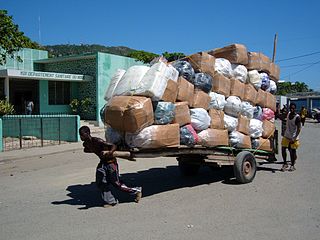
A cart or dray is a vehicle designed for transport, using two wheels and normally pulled by one or a pair of draught animals. A handcart is pulled or pushed by one or more people.

A shopping cart, trolley, or buggy, also known by a variety of other names, is a wheeled cart supplied by a shop or store, especially supermarkets, for use by customers inside the premises for transport of merchandise as they move around the premises, while shopping, prior to heading to the checkout counter, cashiers or tills. Increasing the amount of goods a shopper can collect increases the quantities they are likely to purchase in a single trip, boosting store profitability.

A carriage is a private four-wheeled vehicle for people and is most commonly horse-drawn. Second-hand private carriages were common public transport, the equivalent of modern cars used as taxis. Carriage suspensions are by leather strapping and, on those made in recent centuries, steel springs. Two-wheeled carriages are informal and usually owner-driven.

A wagon or waggon is a heavy four-wheeled vehicle pulled by draught animals or on occasion by humans, used for transporting goods, commodities, agricultural materials, supplies and sometimes people.
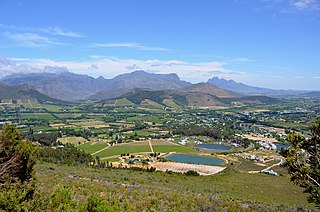
Franschhoek is a small town in the Western Cape Province and one of the oldest towns of the Republic of South Africa. It is about 75 kilometres from Cape Town and has a population of slightly over 17,000 people. Since 2000, it has been incorporated into Stellenbosch Municipality.
A chaise, sometimes called chay or shay, is a light two- or four-wheeled traveling or pleasure carriage for one or two people with a folding hood or calash top. The name, in use in England before 1700, came from the French word "chaise" through a transference from a sedan-chair to a wheeled vehicle.

The Blue Train travels an approximately 1,600-kilometre (990 mi) journey in South Africa between Pretoria and Cape Town. It is one of the most luxurious train journeys in the world. It boasts butler service, two lounge cars, an observation car, and carriages with gold-tinted picture windows, in soundproofed, fully carpeted compartments, each featuring its own en-suite. The service is promoted as a "magnificent moving five-star hotel" by its operators, who note that kings and presidents have travelled on it.

A bullock cart or ox cart is a two-wheeled or four-wheeled vehicle pulled by oxen. It is a means of transportation used since ancient times in many parts of the world. They are still used today where modern vehicles are too expensive or the infrastructure favor them.
Shosholoza Meyl is a division of the Passenger Rail Agency of South Africa (PRASA) that operates long-distance (intercity) passenger rail services. It operates various train routes across South Africa, carrying approximately 4 million passengers annually. Before 2009, Shosholoza Meyl was a division of Spoornet, but it was transferred after the formation of PRASA.

A horse-drawn vehicle is a mechanized piece of equipment pulled by one horse or by a team of horses. These vehicles typically had two or four wheels and were used to carry passengers and/or a load. They were once common worldwide, but they have mostly been replaced by automobiles and other forms of self-propelled transport.

A dogcart is a light horse-drawn vehicle, originally designed for sporting shooters, with a box behind the driver's seat to contain one or more retriever dogs. The dog box could be converted to a second seat. Later variants included :

Metrorail Western Cape is a network of commuter and suburban rail services in the City of Cape Town Metropolitan Municipality and in the surrounding towns of Malmesbury, Paarl, Stellenbosch and Wellington in the Western Cape province of South Africa.

Driving, when applied to horses, ponies, mules, or donkeys, is a broad term for hitching equines to a wagon, carriage, cart, sleigh, or other horse-drawn vehicle by means of a harness and working them in this way. It encompasses a wide range of activities from pleasure driving, to harness racing, to farm work, horse shows, and even international combined driving.

The Ordnance BLC 15-pounder gun was a modernised version of the obsolete BL 15-pounder 7 cwt gun, incorporating a recoil and recuperator mechanism above the barrel and a modified quicker-opening breech. It was developed to provide Territorial Force artillery brigades with a reasonably modern field gun without incurring the expense of equipping them with the newer 18-pounder. It is the gun that writers usually mean by "15-pounder gun" in World War I, but can be confused with the earlier Ordnance QF 15-pounder Ehrhardt or Ordnance BL 15-pounder, both of which fired the same shell.
South African Post Office is the national postal service of South Africa and as a state owned enterprise, its only shareholder is the South African government. In terms of South African law, the Post Office is the only entity legally allowed to accept reserved mail and as such operates a monopoly. It employs over 16,480 people and operates more than 1,400 postal outlets throughout the country and therefore has a presence in almost every single town and city in South Africa. Nomkhita Mona joined the SA Post Office in April 2021 as group CEO. Its main subsidiary is Postbank, a financial services provider.
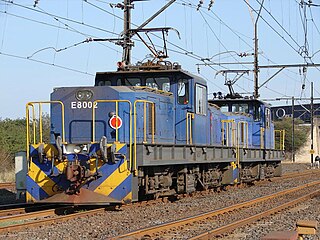
The South African Railways Class 8E of 1983 is an electric locomotive.

The South African Railways Class 35-000 of 1972 is a diesel-electric locomotive.
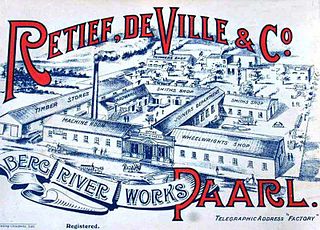
Retief, de Ville & Co. were coachbuilders based in Paarl in the Western Cape, flourishing at a time when the Kimberley Diamond Rush and Witwatersrand Gold Rush saw an upsurge in the demand for reliable conveyances in South Africa.

The Kowie Railway 4-4-0T of 1882 was a South African steam locomotive from the pre-Union era in the Cape of Good Hope.
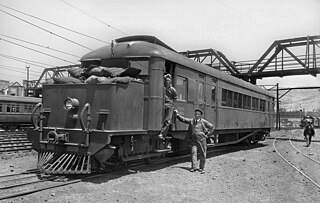
The South African Railways Clayton Railmotor of 1929 was a steam railmotor.

















